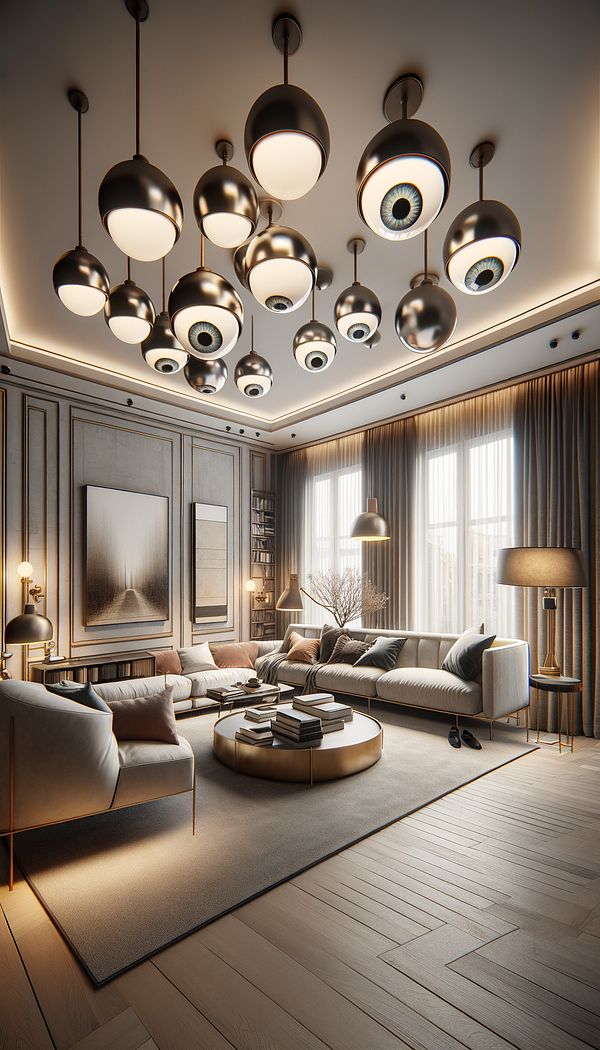What is Eyeball Spots?
Eyeball spots are adjustable recessed lighting fixtures that allow the direction of the light to be changed.
Description
In the world of interior design, lighting plays a crucial role in setting the tone and ambiance of a space. Among the myriad of lighting options available, eyeball spots offer a distinct and versatile solution. These are a type of recessed lighting fixture, also known as 'gimbal lights', designed to be installed flush with the surface of a ceiling or wall. What sets eyeball spots apart is their adjustable nature. The inner 'eyeball' can be rotated or tilted, allowing the direction of the light beam to be altered based on the specific needs or desired effect in a space.
This ability to direct light makes eyeball spots particularly useful for highlighting artwork, architectural features, or specific areas within a room. They can provide focused lighting without the clutter of surface-mounted fixtures, helping to maintain a clean and unobstructed aesthetic. Furthermore, when used strategically, these lights can create dynamic lighting schemes that add depth and drama to an interior space.
The installation and usage of eyeball spots require consideration of various factors, such as the size and shape of the space, the ceiling height, and the specific elements you wish to illuminate. Proper placement and angling are crucial to achieve the intended effect and to avoid common lighting pitfalls, like glare or uneven illumination.
Usage
Eyeball spots are commonly used in residential and commercial settings alike. They fit seamlessly into modern, minimalistic designs but can also complement more traditional or eclectic aesthetics. In a living room, for example, they might be angled to highlight a piece of art or an architectural detail like a fireplace. In a retail space, they can be directed at display shelves or products to attract attention. Because of their flexibility, eyeball spots are also excellent for task lighting in areas like kitchens or offices, where the focus of lighting might need to be adjusted based on the task at hand.
FAQs
-
Can eyeball spots be used in outdoor settings?
While most eyeball spots are designed for indoor use, there are specific models that are rated for outdoor use. These are usually weatherproof and designed to withstand the elements.
-
How do I choose the right size and number of eyeball spots for my space?
The size and number of eyeball spots required depend on the size of your space and what you're trying to illuminate. As a general rule, larger and more open spaces require bigger or more numerous fixtures. Consulting with a lighting designer or interior designer can help determine the optimal setup.
-
Can LED bulbs be used in eyeball spots?
Yes, many eyeball spots are compatible with LED bulbs, which are energy-efficient and have a longer lifespan compared to traditional bulbs. Always check the fixture's specifications to ensure compatibility.
Practical Application
When implementing eyeball spots into your design, it's important to plan their placement carefully to ensure they meet your lighting needs. Consider the activities that occur in the space, the features you wish to highlight, and potential glare spots. It's also worth experimenting with the angle of the light to find the most flattering and functional setups. For an energy-efficient approach, opt for LED bulbs that suit the fixture's specifications. Finally, consulting a professional can provide valuable insights into achieving your desired lighting effects while adhering to electrical safety standards.
-
SaturationSaturation refers to the intensity or purity of a color.
-
French ClassicFrench Classic refers to an interior design style originating from France, characterized by its elegance, opulence, and emphasis on symmetry and proportion.
-
BaffleA baffle is a device used to obstruct, break up, or redirect sound waves.
-
ChandelierA chandelier is a decorative ceiling-mounted light fixture.
-
Task LightingTask lighting refers to light sources specifically designed to assist in the execution of activities that require focused illumination.
